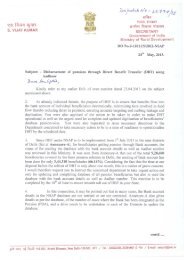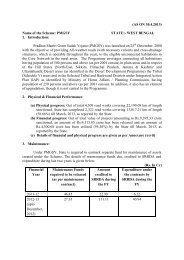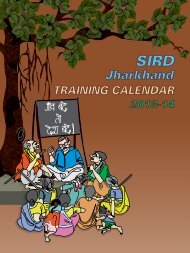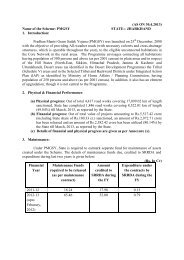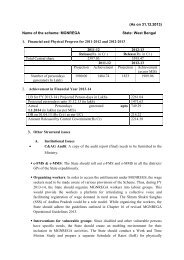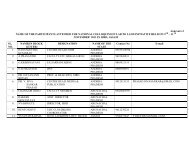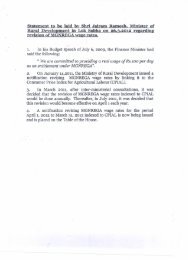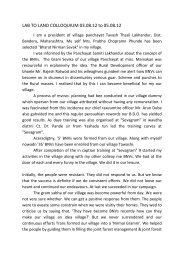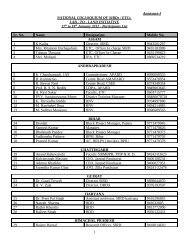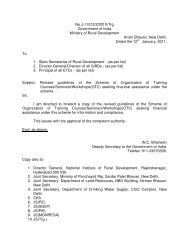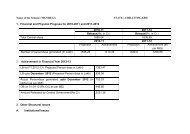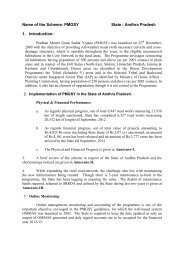A Unique Intervention to fight malnutrition among children ... - Diksha
A Unique Intervention to fight malnutrition among children ... - Diksha
A Unique Intervention to fight malnutrition among children ... - Diksha
Create successful ePaper yourself
Turn your PDF publications into a flip-book with our unique Google optimized e-Paper software.
KILLOL Project: A <strong>Unique</strong> <strong>Intervention</strong> <strong>to</strong> <strong>fight</strong> <strong>malnutrition</strong> <strong>among</strong> <strong>children</strong>Background:Gujarat has high levels of child <strong>malnutrition</strong> which is 47% as compared <strong>to</strong> the national averageof 21% i . There are also regional disparities within the State and in the district identified for theLab <strong>to</strong> Land Initiative Sabarkantha, there are about 34 % <strong>children</strong> who are malnourished and ou<strong>to</strong>f these 3% fall under the severe malnourished category ii . Gujarat is a State noted for reformsand good governance in almost every field of development but child <strong>malnutrition</strong> still persistsand is a big challenge here. A child’s entire life is determined in large measures by the food given <strong>to</strong>him during his first fiveyears. Because a childhood period is one of rapid growth and developmentnutrition is one of theinfluencing fac<strong>to</strong>rs in this period. Malnutrition causes a great deal of physicaland emotionalsuffering and it is a violation of a child's human rights. Malnutrition substantially raisesthe risk ofinfant and child deaths, and increasesthe vulnerability <strong>to</strong> a variety of diseases in later life.Childrenwho are undernourished and underweighted are likely <strong>to</strong> be less clever than if they werewellfed iii . Health of <strong>children</strong> is of great importance as rapid growth occurs during this period .Goodnutrition is a basic requirement for good health and a living organism is a product of nutritionThe nutrition of a child being of vital importance in the process of nation building, there are a largenumber of programs and policies iv <strong>to</strong> combat this problem. In Gujarat it is seen that <strong>malnutrition</strong>is not only affecting <strong>children</strong> but adults are also suffering from many macro µnutrientsdeficiencies v .The intervention by the DDO Sabarkantha was initiated when it was realized that combatting<strong>malnutrition</strong> is one of the Millennium Development Goals (MDG) vi .Malnutrition is directly orindirectly related <strong>to</strong> the infant mortality rate and under 5 (yrs.) mortality rate. Malnutrition is anunderlying cause for 50 % of the infant mortality cases. In Himatnagar taluka of SabarkanthaDistrict almost 37 % of ICDS beneficiaries between age group of 6 months <strong>to</strong> 5 years aremalnourished out of which 3 % are severely malnourished vii .
It can be seen that <strong>malnutrition</strong> is persistent all over Gujarat and Sabarkantha comes in the highest range. “India is ranked 2nd in the region of thenumber of <strong>children</strong> suffering from <strong>malnutrition</strong>, after Bangladesh (in 2010), and 21% of the <strong>children</strong> exhibit a degree of <strong>malnutrition</strong>." WorldBank India Country Report , 2010Impact of Malnutrition:Good nutrition is ensured by the regular intake of a balanced diet, which is capable of supportingthe individual consuming it, in a state of good health by providing the desired nutrients inrequired amounts. It must provide the right amount of fuel <strong>to</strong> execute normal physical activity. Ifthe <strong>to</strong>tal amount of nutrients provided in the diet is insufficient, a state of under nutrition willdevelop. Under nutrition will lead <strong>to</strong> <strong>malnutrition</strong> andultimately <strong>to</strong> severe <strong>malnutrition</strong>.A child’sentire life is determined in large measures by the food given <strong>to</strong> him during his first fiveyears.Malnutrition is characterized by a wide array of health problems, including extremeweight loss, stunted growth, weakened resistance <strong>to</strong> infectious disease & impairment of intellect.Severe cases of <strong>malnutrition</strong> can lead <strong>to</strong> death. The effects of <strong>malnutrition</strong> on a community areboth direct (subclinical nutrition deficiency disease like kwashiorkor, PEM (Protein Energy<strong>malnutrition</strong>) & indirect (high morbidity & mortality rate <strong>among</strong> young <strong>children</strong>) and finallyaffect the life of the community.Damaging effects of <strong>malnutrition</strong> can pass from one generation <strong>to</strong> the next. Giving a childa solid nutritional start has an impact his/herlife, on the physical, mental and social development.It may be also noted that a child’s nutritional future begins before conception with the mother’snutritional status prior <strong>to</strong> pregnancy.Not only is nutrition important for a child but also for its mother. If a woman is not takingproper nutrition during pregnancy her child can haveLBW(Low Birth Weight) and if a child is
not consuming sufficient nutrition after birth, he/she can suffer from protein energy <strong>malnutrition</strong>,nutritional anemia, night blindness, rickets and suffer adverse mental growth.Fac<strong>to</strong>rs Affecting the Nutrition: Cultural Influences:1. Food habits, cus<strong>to</strong>ms & belief2. Religious beliefs3. Food fads4. Cooking practices, child rearing practices Socio-Economic Fac<strong>to</strong>rs:1. Poverty2. Awareness3. Education4. KnowledgeKILLOL- Child Malnutrition Control Project:The KILLOL viii project is based on the premise that if a child has sufficient nutrition thenonly will there be a healthy smile on his/her face. Adequate nutrition during infancy is essentialfor lifelong health and wellbeing. Infants should be exclusively breastfed for the first six monthsof life <strong>to</strong> achieve optimal growth, development and health. Thereafter, <strong>to</strong> meet their evolvingnutritional requirements, infants should receive nutritionally adequate and safe complementaryfoods.To achieve the goal of MDG- <strong>to</strong> reduce <strong>malnutrition</strong> in <strong>children</strong> from 47 % <strong>to</strong> 25% ix ,District Development Officer Mr Ravi Kumar Arora (IAS) has initiated this project named“KILLOL- CHILD MALNUTRITION CONTROL PROJECT” in Himatnagar block (districtSabarkantha).This project was inaugurated by our Honorable Chief Minister ShriNarendraModion 06-04-2011.Before starting the project it was decided <strong>to</strong> coin an effective name for theproject and for that DDO invited names from his team in the health department. Thus he coinedthe name KILLOL for the project in participa<strong>to</strong>ry and democratic manner. The name has animmediate socio-cultural impact and creates and empathy and awareness in the rural areas.The DDO then decided <strong>to</strong> identify the fac<strong>to</strong>rs which affect the nutritional status of a childin the identified blockand did this through a household survey x that identifies the socio-economicstatus of the family, their literacy levels, food habits, sanitation habits, habitat dwellings,electricity availability etc.The survey identified a <strong>to</strong>tal of 554<strong>children</strong> in the block aged 6months <strong>to</strong> 5 years<strong>children</strong>. As a third step <strong>to</strong> the project all these <strong>children</strong> were then given a medical checkup and
out of this 455 were identified as being in the severe malnourished category. A further 6 of themwere referred <strong>to</strong> tertiary care.Objective and Methodology:The objective of KILLOL is <strong>to</strong> improve the nutritional status of <strong>children</strong> in the block andgive health & nutrition education <strong>to</strong> the community especially <strong>to</strong> mothers, reduce under 5 yearchild mortality because of <strong>malnutrition</strong> and improve the physical & mental health of this agegroup.1. The project mainly focused on improving nutritional status of all the grade 3 <strong>children</strong>aged 6 months <strong>to</strong> 5 years of age.2. All the grade 3 <strong>children</strong> as per ICDS data were screened in respective PHCs by theMedical officer and underwent lab tests like hemoglobin examination, blood grouping,urine/s<strong>to</strong>ol test for detecting the presence of any other existing disease/ condition.3. All the screened grade 3 <strong>children</strong> were then provided supplementary nutrition at therespective anganwadi center for 3 months (up <strong>to</strong> 24.7.2011)4. The supplementary nutrition was given in the form of AMUL milk powder (2tsp)+Horlicks (1 tsp) in lukewarm water every day.5. De-worming & IFA tabletsand vitamin A were given in a syrup form.6. Thereafter in the case of the <strong>children</strong> suffering from disease and some medicalcomplication, this supplementary food was s<strong>to</strong>pped immediately and the child was referred <strong>to</strong>nearest PHC immediately.7. Three follow up medical examinations xi were carried out including Lab test and weightalong with general health check up by medical officer and treated if required was given.Some serious cases are being referred <strong>to</strong> a pre-defined private pediatrician on a convenientdate.A pho<strong>to</strong> ID card for the project has been developed specially, which includes 1. Generalinformation of the child. 2. General medical checkup details of the child. 3. Progressive chart forall stages. 4. Requirement of daily nutritious elements and availability of nutritious elementsrelated information. The pho<strong>to</strong> ID card is kept with the child’s mother or guardian and the basicdata has been entered by the survey staff of the health dept. Thereafter data has been recordedand entered by the doc<strong>to</strong>rs who have carried out the medical examinations.Human Resources:
The officers and workers xii involved in the project KILLOL over and above their regularduties are as shown here.No. Name of Officer Designation.1 Mr.RaviAroraIAS DDO SK2 Dr.SatishK.Makvana RCHO SK3 Mrs.Bhagavatiben PO ICDS SKNo. Officer/worker Nos.1 Block Health Officer Himatnagar 12 Medical Officers&Ayush,DPA 10 (Mos) 6 (Ayush),13 CDPO Himatnagar 14 BIECO,HV,MPHS,Pharmacist 2,5,2,35 FHW,MPW 34,146 Lab Technician, FA 12,67 MS,AW 13,216Referral Analysis of the Killol Project:As informed earlier in the case study, the identified age group for this project is <strong>children</strong>of theblock who are below six years of age.Out of the <strong>to</strong>tal <strong>children</strong> 455 were examined as they wereseen <strong>to</strong> be weak and listless. Out of the 455 during baseline survey, 127 were foundmalnourished after medical examination and 6 were found <strong>to</strong> be suffering from various diseasesand infections. These were treated by specialists after referral services were initiated.121<strong>children</strong>were provided nutritive food at the nearest identified anganvadi till the first follow up medicalcheckup. At the time of first checkup (7.5.2011) it was seen that the number of malnourished<strong>children</strong> was reduced from 121 <strong>to</strong> 43 and it was further reduced <strong>to</strong> 11 at the time of 2 nd follow upcheckup (24.5.2011). Later on at the time of third medical checkup (23.6.2011)there were nomalnourished <strong>children</strong>.Outcome:During the 1st follow up 357 <strong>children</strong> recorded anincreased weight, 266 an increasedHb% & 86 <strong>children</strong> had a nutrition grade change xiii .At the times of 4th followup (25.7.2011) out of 455;Weight improvement – 440Hb% improvement - 406Grade change-217
And those 6 <strong>children</strong> who have been referred <strong>to</strong> tertiary care as they are suffering from severedisease like heart disease, urinary tract infection or retinal problems are also getting treatment inbigger hospitals of Ahmedabad. The status of six <strong>children</strong> referred <strong>to</strong> specialists for tertiary careis shown as under:The key observations: child mortality because of <strong>malnutrition</strong> can be reduced if;A balanced diet is provided, that includes the consumption of milk & milk products(which are a good source of protein) green vegetables(source of vitamin A & iron) cRegular & continuous moni<strong>to</strong>ring & health checkupsCommunity awareness & health educationCooperation within different sections of the health department and between the healthdepartment and other related departments.The results so far have been encouraging for the project. As a pilot project the DDO hadselected Himatnagar block and now this project has been initiated in the Moyad village of theLab <strong>to</strong> Land block of Prantij which falls in the same district. The survey work has already beeninitiated by the BNV of the village and the results will be brought <strong>to</strong> the National Colloquim.
iMalnourishment <strong>among</strong> <strong>children</strong> in India; a regional analysis – Indian Rank, World Bank Report 2005iiAs per local survey conducted by District Health Department, Sabarkantha District in 2011.iiiWHO ReportLife in the 21st century – A vision for all. Geneva:iv Various nutritious programs in the State are covered under the ICDS, and cover <strong>children</strong>, the nursing mothers, pregnantwomen and school going <strong>children</strong>vThe major deficiencies are anemia, goiter, calcium deficiency and these are referred <strong>to</strong> in the “Adult macro & micro<strong>malnutrition</strong>” chapter of the NFHS III, 2005viMillennium Development Goals, UN, 2000, adopted by India and published by the Direc<strong>to</strong>rate of Eco & Stats, Govt. ofIndia IMR and MMR are Goal 6.viiAs per local survey conducted by District Health Department, Sabarkantha District in 2011.viiiKillol is a Gujarati word loosely translated <strong>to</strong> mean the joy and gay abandonment of a child or group of <strong>children</strong> playingix Millennium Development Goals, UN, 2000, adopted by India and published by the Direc<strong>to</strong>rate of Eco & Stats, Govt. ofIndiaxDistrict level Household Survey 2002-04 , an independent agencyxianthropometry is the most useful <strong>to</strong>ol forassessing the nutritional status of <strong>children</strong>. There are many anthropometricindica<strong>to</strong>rs in use,such as mid upper arm circumference (MUAC), weight for age, height for age, weight for height,and bodymass index of Quetlet.xii Abbreviations in the table are RCHO-Reproductive Child Health Officer, DPA-District Programme Associate,BIECO-Block Health Information & Education &CommuncationOfficer,HV-Health Visi<strong>to</strong>rMPHS-Multi Purpose Health Supervisor,FHW-Female Health Worker,MPW- Multi Purpose WorkerFA-Financial Assistant,MS-MukhyaSevika, AW-Anganwadi Workerxiii The Grade formulae first introduced by Weech,using age as variable and is a <strong>to</strong>ol developed by the National Center forHealth Statistics (NCHS), New DelhiDr. GauriTrivediDirec<strong>to</strong>rSIRD-SPIPA ,Gujarat



